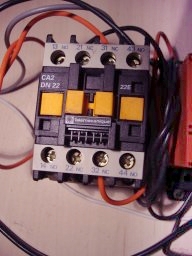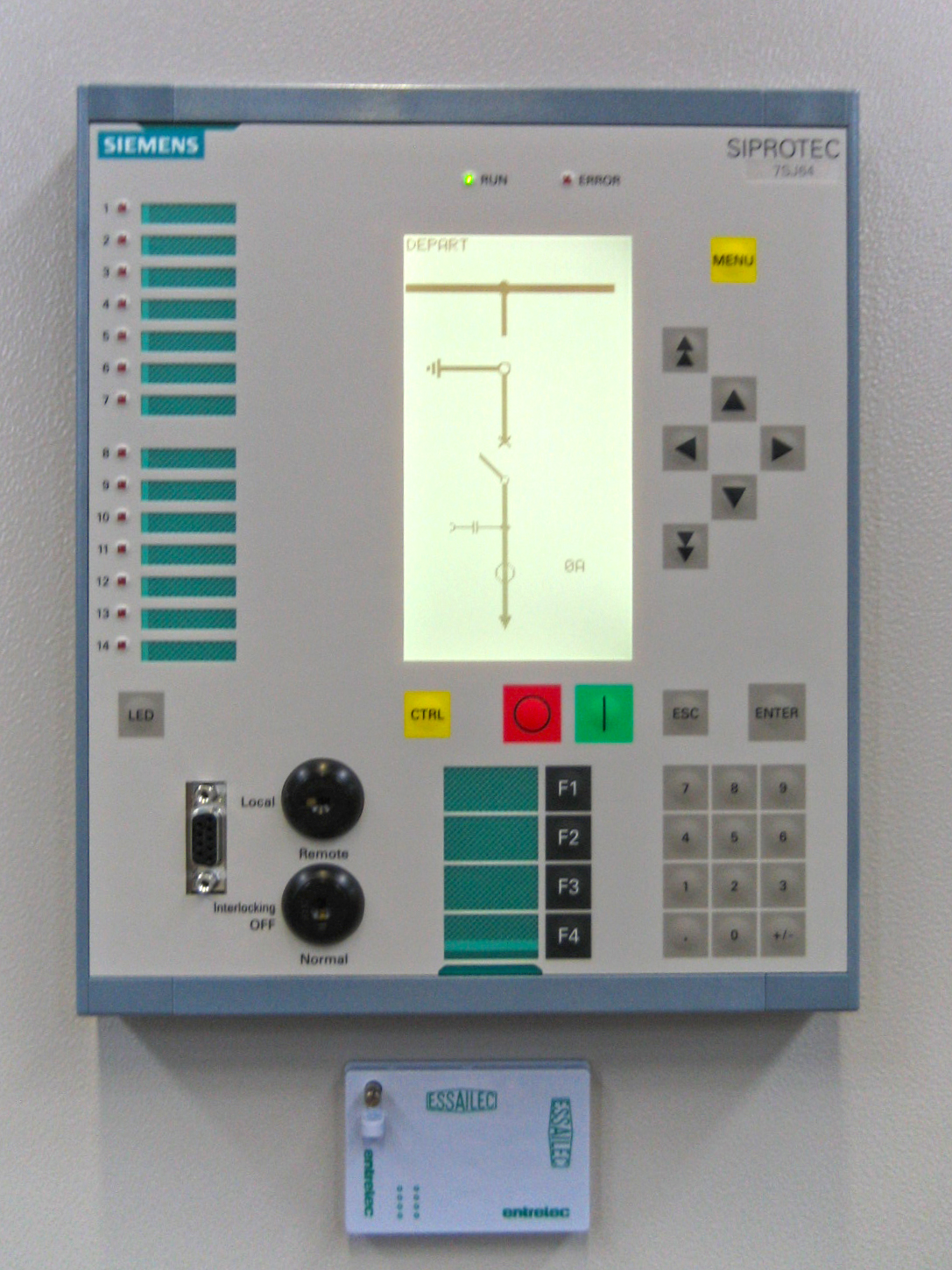|
Magnetic Starter
A magnetic starter is an electromagnetically operated switch which provides a safe method for starting an electric motor with a large load. Magnetic starters also provide under-voltage and overload protection and an automatic cutoff in the event of a power failure. Implementation A magnetic starter has a contactor and an overload relay, which will open the control voltage to the starter coil if it detects an overload on a motor. Overload relays may rely on heat produced by the motor current to operate a bimetal contact or release a contact held closed by a low-melting-point alloy. The overload relay opens a set of contacts that are wired in series with the supply to the contactor feeding the motor. The characteristics of the heaters can be matched to the motor so that the motor is protected against overload. Recently, microprocessor-controlled motor digital protective relays offer more comprehensive protection of motors. Due to the electromagnet in the contactor, if power to the ... [...More Info...] [...Related Items...] OR: [Wikipedia] [Google] [Baidu] |
Contactor
:''In semiconductor testing, contactors can also be referred to as the specialized socket that connects the device under test.'' :''In process industries, a contactor is a vessel where two streams interact, for example, air and liquid. See Gas-liquid contactor.'' A contactor is an electrically-controlled switch used for switching an electrical power circuit. A contactor is typically controlled by a circuit which has a much lower power level than the switched circuit, such as a 24-volt coil electromagnet controlling a 230-volt motor switch. Unlike general-purpose relays, contactors are designed to be directly connected to high-current load devices. Relays tend to be of lower capacity and are usually designed for both ''normally closed'' and ''normally open'' applications. Devices switching more than 15 amperes or in circuits rated more than a few kilowatts are usually called contactors. Apart from optional auxiliary low-current contacts, contactors are almost exclusively fitted ... [...More Info...] [...Related Items...] OR: [Wikipedia] [Google] [Baidu] |
Overload Protection Relay
A relay Electromechanical relay schematic showing a control coil, four pairs of normally open and one pair of normally closed contacts An automotive-style miniature relay with the dust cover taken off A relay is an electrically operated switch. It consists of a set of input terminals for a single or multiple control signals, and a set of operating contact terminals. The switch may have any number of contacts in multiple contact forms, such as make contacts, break contacts, or combinations thereof. Relays are used where it is necessary to control a circuit by an independent low-power signal, or where several circuits must be controlled by one signal. Relays were first used in long-distance telegraph circuits as signal repeaters: they refresh the signal coming in from one circuit by transmitting it on another circuit. Relays were used extensively in telephone exchanges and early computers to perform logical operations. The traditional form of a relay uses an electromagnet to c ... [...More Info...] [...Related Items...] OR: [Wikipedia] [Google] [Baidu] |
Bimetal
Bimetal refers to an object that is composed of two separate metals joined together. Instead of being a mixture of two or more metals, like alloys, bimetallic objects consist of layers of different metals. Trimetal and tetrametal refer to objects composed of three and four separate metals respectively. A bimetal bar is usually made of brass and iron. Bimetallic strips and disks, which convert a temperature change into mechanical displacement, are the most recognized bimetallic objects due to their name. However, there are other common bimetallic objects. For example, tin cans consist of steel covered with tin. The tin prevents the can from rusting. To cut costs and prevent people from melting them down for their metal, coins are often composed of a cheap metal covered with a more expensive metal. For example, the United States penny was changed from 95% copper to 95% zinc, with a thin copper plating to retain its appearance. A common type of trimetallic object (before the all-alum ... [...More Info...] [...Related Items...] OR: [Wikipedia] [Google] [Baidu] |
Wire
Overhead power cabling. The conductor consists of seven strands of steel (centre, high tensile strength), surrounded by four outer layers of aluminium (high conductivity). Sample diameter 40 mm A wire is a flexible strand of metal. Wire is commonly formed by drawing the metal through a hole in a die or draw plate. Wire gauges come in various standard sizes, as expressed in terms of a gauge number. Wires are used to bear mechanical loads, often in the form of wire rope. In electricity and telecommunications signals, a "wire" can refer to an electrical cable, which can contain a "solid core" of a single wire or separate strands in stranded or braided forms. Usually cylindrical in geometry, wire can also be made in square, hexagonal, flattened rectangular, or other cross-sections, either for decorative purposes, or for technical purposes such as high-efficiency voice coils in loudspeakers. Edge-wound coil springs, such as the Slinky toy, are made of special flatten ... [...More Info...] [...Related Items...] OR: [Wikipedia] [Google] [Baidu] |
Digital Protective Relay
In utility and industrial electric power transmission and distribution systems, a numerical relay is a computer-based system with software-based protection algorithms for the detection of electrical faults. Such relays are also termed as microprocessor type protective relays. They are functional replacements for electro-mechanical protective relays and may include many protection functions in one unit, as well as providing metering, communication, and self-test functions. Description and definition The digital protective relay is a protective relay that uses a microprocessor to analyze power system voltages, currents or other process quantities for the purpose of detection of faults in an electric power system or industrial process system. A digital protective relay may also be called a "numeric protective relay". It is also called numerical relay. Input processing Low voltage and low current signals (i.e., at the secondary of a voltage transformers and current transformers ... [...More Info...] [...Related Items...] OR: [Wikipedia] [Google] [Baidu] |
Latching Switch
A latching switch is a switch that maintains its state after being activated. A push-to-make, push-to-break switch would therefore be a latching switch – each time you actuate it, whichever state the switch is left in will persist until the switch is actuated again. Gallery File:ABB E256-230.JPG, ABB E256 latching relay File:Z-S230-SO.JPG, Moeller Z-S230 latching relay File:Multiway switching.JPG, wiring diagram of latching switch File:GE MEM relay.JPG, example of latching switch using GE PLS+ relay See also * Latching relay * Toggle switch In electrical engineering, a switch is an electrical component that can disconnect or connect the conducting path in an electrical circuit, interrupting the electric current or diverting it from one conductor to another. The most common type of ... References Switches {{technology-stub ... [...More Info...] [...Related Items...] OR: [Wikipedia] [Google] [Baidu] |
Light Switch
In electrical wiring, a light switch is a switch most commonly used to operate electric lights, permanently connected equipment, or electrical outlets. Portable lamps such as table lamps may have a light switch mounted on the socket, base, or in-line with the cord. Manually operated on/off switches may be substituted by dimmer switches that allow controlling the brightness of lamps as well as turning them on or off, time-controlled switches, occupancy-sensing switches, and remotely controlled switches and dimmers. Light switches are also found in flashlights, vehicles, and other devices. Wall-mounted switches Switches for lighting may be in hand-held devices, moving vehicles, and buildings. Residential and commercial buildings usually have wall-mounted light switches to control lighting within a room. Mounting height, visibility, and other design factors vary from country to country. The switch mounting boxes, or enclosures are often recessed within a finished wall. Surface moun ... [...More Info...] [...Related Items...] OR: [Wikipedia] [Google] [Baidu] |
Momentary Switch
In electrical engineering, a switch is an electrical component that can disconnect or connect the conducting path in an electrical circuit, interrupting the electric current or diverting it from one conductor to another. The most common type of switch is an electromechanical device consisting of one or more sets of movable electrical contacts connected to external circuits. When a pair of contacts is touching current can pass between them, while when the contacts are separated no current can flow. Switches are made in many different configurations; they may have multiple sets of contacts controlled by the same knob or actuator, and the contacts may operate simultaneously, sequentially, or alternately. A switch may be operated manually, for example, a light switch or a keyboard button, or may function as a sensing element to sense the position of a machine part, liquid level, pressure, or temperature, such as a thermostat. Many specialized forms exist, such as the toggle switch, ... [...More Info...] [...Related Items...] OR: [Wikipedia] [Google] [Baidu] |
Latching Switch
A latching switch is a switch that maintains its state after being activated. A push-to-make, push-to-break switch would therefore be a latching switch – each time you actuate it, whichever state the switch is left in will persist until the switch is actuated again. Gallery File:ABB E256-230.JPG, ABB E256 latching relay File:Z-S230-SO.JPG, Moeller Z-S230 latching relay File:Multiway switching.JPG, wiring diagram of latching switch File:GE MEM relay.JPG, example of latching switch using GE PLS+ relay See also * Latching relay * Toggle switch In electrical engineering, a switch is an electrical component that can disconnect or connect the conducting path in an electrical circuit, interrupting the electric current or diverting it from one conductor to another. The most common type of ... References Switches {{technology-stub ... [...More Info...] [...Related Items...] OR: [Wikipedia] [Google] [Baidu] |
Motor Controller
A motor controller is a device or group of devices that can coordinate in a predetermined manner the performance of an electric motor. A motor controller might include a manual or automatic means for starting and stopping the motor, selecting forward or reverse rotation, selecting and regulating the speed, regulating or limiting the torque, and protecting against overloads and electrical faults. Motor controllers may use electromechanical switching, or may use power electronics devices to regulate the speed and direction of a motor. Applications Motor controllers are used with both direct current and alternating current motors. A controller includes means to connect the motor to the electrical power supply, and may also include overload protection for the motor, and over-current protection for the motor and wiring. A motor controller may also supervise the motor's field circuit, or detect conditions such as low supply voltage, incorrect polarity or incorrect phase sequence, or h ... [...More Info...] [...Related Items...] OR: [Wikipedia] [Google] [Baidu] |
Push Switch
A push switch (button) is a momentary or non-latching switch which causes a temporary change in the state of an electrical circuit only while the switch is physically actuated. An automatic mechanism (i.e. a spring) returns the switch to its default position immediately afterwards, restoring the initial circuit condition. There are two types: * A 'push to make' switch allows electricity to flow between its two contacts when held in. When the button is released, the circuit is broken. This type of switch is also known as a Normally Open (NO) Switch. (Examples: doorbell, computer case power switch, calculator buttons, individual keys on a keyboard) * A 'push to break' switch does the opposite, i.e. when the button is not pressed, electricity can flow, but when it is pressed the circuit is broken. This type of switch is also known as a Normally Closed (NC) Switch. (Examples: Fridge Light Switch, Alarm Switches in Fail-Safe circuits) Many Push switches are designed to functio ... [...More Info...] [...Related Items...] OR: [Wikipedia] [Google] [Baidu] |


.jpg)


